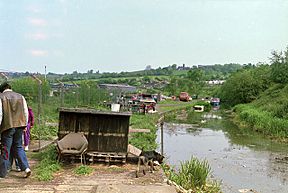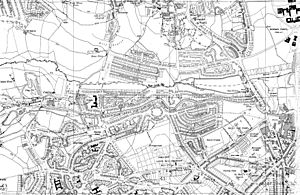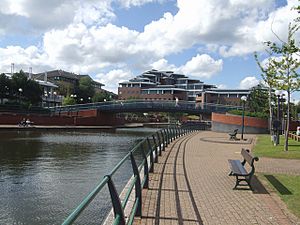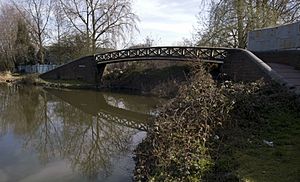Dudley Canal facts for kids
Quick facts for kids Dudley Canal |
|
|---|---|

The end of the No. 2 Line near Hawne Basin in 1987
|
|
| Specifications | |
| Locks | 12 (originally 14) |
| Original number of locks | 14 |
| Status | part navigable |
| Navigation authority | Canal and River Trust |
| History | |
| Original owner | Dudley Canal Company |
| Date of act | 1776 |
| Geography | |
| Connects to | Birmingham Canal Navigations |
The Dudley Canal is a canal passing through Dudley in the West Midlands of England. The canal is part of the English and Welsh connected network of navigable inland waterways, and in particular forms part of the popular Stourport Ring narrowboat cruising route.
The first short section, which connected to the Stourbridge Canal, opened in 1779, and this was connected through the Dudley Tunnel to the Birmingham Canal system in 1792. Almost immediately, work started on an extension, called Line No. 2, which ran through another long tunnel at Lapal, to reach the Worcester and Birmingham Canal. This was completed in 1798, but significant trade had to wait until the Worcester and Birmingham was completed in 1802. In 1846, the company amalgamated with the Birmingham Canal Navigations, and various improvements followed, including the Netherton Tunnel, of a similar length to the Dudley Tunnel, but much bigger, with towpaths on both sides and gas lighting. It was the last canal tunnel built in England.
Subsidence from coal mining was a significant problem for much of the life of the canal. The Lapal Tunnel was regularly affected, and a section near Blackbrook Junction fell into mine workings in 1894. The route was restored, but the short Two Locks Line nearby was abandoned in 1909, and the Lapal Tunnel, which has used a pump and stop-locks to create flows to assist the boats in their passage, suffered the same fate in 1917. Most of the canal was abandoned in the 1960s, but a committee was formed, which became the Dudley Canal Trust, and restoration took place, culminating in the reopening of Dudley Tunnel in 1973. Lapal Tunnel remains closed, and although the Lapal Tunnel Trust originally campaigned for it to be reopened, they have modified their plans to include a surface route, following the conclusion of an engineering study.
History
The first canal connecting Birmingham to the Staffordshire and Worcestershire Canal (and hence the River Severn, River Trent, and River Mersey) was the Birmingham Canal. This joined the Staffordshire and Worcestershire at Aldersley, near Wolverhampton. The Dudley Canal was seen as part of a scheme to transport coal from coalfields near Dudley to Stourbridge, where it would be used for industry. Limestone and ironstone were other potential cargos. A meeting was held in Stourbridge in February 1775, at which Robert Whitworth was commissioned to survey a route, and the whole cost of the project was promised. The principal promoter was Lord Dudley, and the route ran from Dudley to Stourton on the Staffordshire and Worcestershire. A bill was placed before Parliament in the spring, but there was opposition from the Birmingham Canal Company, and the promoters withdrew it. They then split the canal into two parts, and presented bills for the Stourbridge Canal and the Dudley Canal, both of which became Acts of Parliament on 2 April 1776, despite further opposition from Birmingham.
Thomas Dadford, Sr., was engaged as the engineer and surveyor, and acted in this capacity until 1783, after which he was employed more informally. The junction between the Dudley canal and the Stourbridge canal would be at the foot of the 9-lock Black Delph flight. The Act allowed the company to raise £7,000, and this had been subscribed by July 1778, but was insufficient to finance the work. The company continued to call money on the shares, and raised £9,200 in this way, with each £100 share being worth £128. Construction work was completed by 24 June 1779, apart from a water supply reservoir at Pensnett Chase, although little traffic used the canal until the Stourbridge Canal was completed in December of that year. As built, the canal terminated at two basins at Great Ox Leasow and Little Ox Leasow, both built on land owned by T. T. Foley, one of the main shareholders.
Dudley Tunnel
In 1784, the Stourbridge and Dudley companies approached the Birmingham Canal about a junction. This would involve building extra locks at Park Head, and a tunnel which would link to Lord Dudley's existing mining tunnel, which joined the Birmingham Canal at Tipton. The Birmingham company agreed, but imposed heavy tolls on traffic using the junction, to compensate for the loss of revenue of goods which would formerly have travelled via Aldersely Junction. Lord Dudley agreed to sell his tunnel to the Dudley Canal Company, but never received any payment, as the beneficial tolls and usefulness of the new canal were deemed to be adequate compensation. An Act of Parliament was obtained in July 1785 to authorise the work, which had been surveyed by John Snape and John Bull, and checked by Dadford, who then became consulting engineer. Abraham Lees was the on-site engineering manager, and the main contract for the tunnel went to John Pinkerton. Its width was to be 9.25 feet (2.82 m), with 7 feet (2.1 m) of headroom and 5.5 feet (1.7 m) of water. The contract specified that it should be finished by 25 March 1788. In 1787, Pinkerton's work was thought to be unsatisfactory, and work stopped while arguments took place. Dadford was paid off, Pinkerton had to pay half of his £4,000 bond, and work restarted with Isaac Pratt in charge. He was a member of both the Stourbridge and the Dudley committees. Lees retained his position.
In May 1789, there were further issues, when it was discovered that the tunnel was not straight. Pratt resigned, and Josiah Clowes was engaged to complete the project. He finished the tunnel, built a new junction with the Birmingham Canal at Tipton, and a reservoir at Gad's Green. Completion was announced at a shareholder's meeting on 25 June 1792, and the official opening was on 15 October.
Line No. 2
With the tunnel just finished, a meeting was held in Birmingham on 31 August 1792, at which a canal from Birmingham to serve the collieries at Netherton was proposed. The following day, the canal company proposed their own version of a similar canal, and following meetings with the Worcester and Birmingham Canal, whose line it would join, it was agreed that those who had been at the meeting would raise £61,500, and that the remaining £28,500 required would be subscribed by existing Dudley shareholders. The line would be constructed at the same level as the Dudley Canal at Park Head. A tunnel of 3,795 yards (3,470 m) would be required at Lapal, and a shorter one of 537 yards (491 m) at Gosty Hill. Another short tunnel was to be built at Halesowen, but became a cutting and bridge when work began. The length of the canal was to be 10.8 miles (17.4 km), for which the working capital would be £90,000, with an additional £40,000 if required. John Snape carried out a survey, and despite opposition from the Birmingham Canal, the Staffordshire and Worcestershire Canal, and a contingent of iron foundries in Wolverhampton, an Act of Parliament was obtained in 1793. The Stratford-upon-Avon Canal was authorised soon afterwards, which would provide a connection to London.
The original route was renamed "Line no 1" to distinguish it from the new "Line no 2" which linked the canal at Park Head Junction (near Netherton) to Halesowen, and then via the tunnel at Lapal to the Worcester and Birmingham Canal at Selly Oak, Birmingham. Work began in early 1794 with Josiah Clowes as engineer and William Underhill as resident engineer. Clowes died in early 1796, and Underhill managed the whole project for a year, after which Robert Whitworth carried out an inspection. He was satisfied, and Underhill continued to manage the construction of the tunnel and an aqueduct near the junction with the No.1 Line, while management of the rest of the project was handled by Benjamin Timmins. The section from Netherton to Halesowen had been built about 1 foot (0.30 m) too high, but this was rectified and the wharf at Halesowen opened for business in early 1797.
Tunnelling proved difficult. Thirty shafts were dug, to provide multiple work faces, but much of the route was through sand, and large quantities of water had to be pumped out of the workings, using three steam engines. The £90,000 had been spent by May 1796, and additional calls on the shares were used to raise the extra £40,000 authorised. Another Act of Parliament was obtained in December 1796, to authorise a further £40,000, and by the time the new route was completed on 28 May 1798, a total of £162.50 had been called on each £100 share. The original shares were worth £118.75, and financial matters were simplified by issuing additional shares so that they all had a nominal value of £100. Lord Dudley resigned from the committee at this point, having steered the company through twenty-two year of construction. The working capital had risen from just £7,000 to over £200,000 in this period, and no dividends had been paid. Traffic through the new tunnel was meagre until 1802, when the Stratford Canal provided a link to the Warwick and Birmingham Canal (later the Grand Union Canal), and hence to London. The first dividend was paid in 1804, and although dividends were never high, they averaged around 4 per cent between 1826 and 1844.
Decline
The original line at Bumble Hole became the Bumble Hole Branch Canal and Boshboil Arm after a collapse of the canal severed part of the loop. Having suffered from mining subsidence for years, the two-locks line was closed in March 1909 and later filled in. The line is now under a late 20th century industrial estate, and only the junctions, towpath bridges and a few yards of watered but unnavigable canal remain.
After repeated collapses, Lapal Tunnel was abandoned in June 1917 leaving a short stretch navigable between Selly Oak and a brick works at California until 1953, after which it was drained and filled in.
Restoration
After a period of disuse following nationalisation in 1948, the first suggestions that the canal and others should be restored were made by the newly formed Inland Waterways Protection Society (IWPS) in 1959. However, the British Transport Commission presented their annual Bill in 1961, in which the Dudley Canal and Tunnel were scheduled to be closed immediately, with no provision to safeguard the route for future restoration. Both the Inland Waterways Association and the IWPS protested, but the protests were ignored, and closure occurred in 1962. Despite this, the Staffordshire and Worcestershire Canal Society explored the tunnel in mid-1963, after which a Dudley Tunnel Committee began running boat trips through it. These proved popular, and the Committee became the Dudley Canal Tunnel Preservation Society on 1 January 1964, eventually becoming the Dudley Canal Trust in 1970.
On 26 June 1970, the Inland Waterways Amenity Advisory Council, a government committee created in May 1968, held a press conference at which recommendations about the future of "remainder" waterways were made to the British Waterways Board. "Remainder" was a classification that indicated there was no obvious commercial future for the waterway. The recommendations included the returning to "cruiseway" status of nine canals, which included the Dudley Canal. The Waterways Recovery Group, formed in 1970 to co-ordinate volunteer involvement in canal restoration, began work on the canal later that year, raising public awareness of the canal and its potential as an amenity. In December 1970, the Birmingham Canal Navigations Working Party produced a report, which was published in early 1971. They recommended to the British Waterways Board that much of the Birmingham Canal system should be retained. Canals were grouped into four categories, the first two of which needed little action or expenditure to make them navigable again. The Dudley Canal was in the third category, where it was suggested that the local authorities through which the canals ran should be included in restoration plans. This plan of action had formed part of the Transport Act 1968, and was adopted soon afterwards for the Dudley Tunnel Branch.
The renamed Dudley Canal Trust began to restore the canal. Over the weekend of 26–27 September 1971, they organised "Dudley Dig and Cruise", at which over 600 people cleared a lock chamber and two lock pounds of debris. In early 1972, Dudley Corporation announced that they would provide half of the cost of restoration, and that the Park Head end of the Tunnel would be landscaped as part of a derelict land regeneration scheme. Some 50,000 tons of mud were removed from the channel by dredging, and the locks reopened later that year. The Dudley tunnel was reopened at Easter 1973, at a ceremony attended by around 14,000 visitors. A short arm north of the tunnel was restored in 1977, as part of the Black Country Museum project. Funding for this was provided by the Job Creation Scheme run by the Manpower Services Commission, as a way to provide work and training for the unemployed. The trust were able to use the museum as a base for their electrically powered trip boat, which by then had taken over 25,000 people into the tunnel since the start of trips in 1964.
Plans for the No. 2 Line moved forwards in 1980, when a boat rally was held at Hawne Basin, a former Great Western Railway interchange, where tubes were moved from boats to trains. The railway had closed in 1967, and the basin had been unused since then, but thirty boats attended the rally, and the Combeswood Canal Trust developed plans for turning it into a marina.
Part of the Lapal Tunnel was unearthed during the construction of the M5 motorway during the 1960s and the void was filled with concrete. The Lapal Canal Trust is working on the restoration of parts of the lost canal and to replace the tunnels with a completely new line, passing over the hill through Woodgate Valley Country Park.
In February 2012 plans for the regeneration of the Selly Oak area were submitted to Birmingham City Council which included a navigable section of canal from a new junction with the Worcester and Birmingham Canal to the recently reconstructed Harborne Lane bridge along the route of the former Dudley Canal.
On 28 February 2016, following re-excavation of part of the Harborne Lane Wharf, a canoe paddled by a member of the Lapal Canal Trust, became the first vessel since 1953, to proceed along the part of the Eastern length of canal which runs through Selly Oak Park and part of which, remains "in water". It was suggested, by members of the trust in attendance, that this may have been the first vessel to operate beyond Harborne Lane Wharf, since the brickworks at the Eastern end of the Lapal Tunnel was closed in 1926. Photographs were posted on the Lapal Canal Trust's website.
Route
The canal forms an end-on junction with the Stourbridge Canal at the foot of the eight Delph Locks. These are usually known as the Nine Locks, even though they were rebuilt in 1858 as a flight of eight. There is a well-restored stable block by lock 3, and a grade II listed lock keepers house near the line of the old locks, which was built in 1779, probably to a standard design by Thomas Dadford. Above the locks, the canal passes Merry Hill Shopping Centre, built on the site of Round Oak Steelworks after its closure in 1983. Although it has been closed for more than 100 years, a cast-iron footbridge, built in 1858, still carries the towpath over the former entrance to the Two Locks Line. An embankment on the side of a hill carries the canal on to Blowers Green Lock, which is the deepest lock on the Birmingham Canal Navigations, as it replaced two earlier locks which were affected by subsidence. Nearby is a pumphouse, managed by the Dudley Canal Trust. At Park Head Junction, Line No. 2 turns off to the south-east, but the original line continues through three locks to a junction with the remains of the Pensnett Canal and the Grazebrook Arm, and into the southern portal of Dudley Tunnel. At the far end is the Black Country Museum, which offers boat trips into the tunnel and associated mines.
Following Line No. 2 from Park Head Junction, the canal passes around Netherton Hill, where there are mass graves for cholera victims in St. Andrew's churchyard, after which is passes through a cutting which is part of the cut made in 1838 to accommodate the construction of Lodge Farm Reservoir. Brewins Tunnel was built here, but was uncapped after 20 years. A short arm managed by the Withymoor Island Trust is located on the west bank and is used for moorings. Beyond it, the Bumble Hole Branch partially encircles Bumble Hole, a water-filled former clay pit. This was once the main line, but the embanked route which cuts off the loop was built as part of the Netherton Tunnel project. Another part of the old loop, the Boshboil Arm, turns to the west opposite Windmill End Junction, where to the north lies the southern portal of Netherton Tunnel. Both this portal and the north portal are grade II listed structures.
From Windmill End Junction, Line No. 2 continues towards the closed Lapal Tunnel. This was once an area of industry, but most of it has gone, to be replaced by housing estates, light industrial units, and playing fields. At the northern end of Gosty Tunnel, a layby marks the site when a tug was once kept to pull barges through the tunnel. Beyond lies Hawne Basin, refurbished as a marina after its use as a railway interchange ceased in 1967. The head of navigation is just beyond the basin entrance. Much of the remaining route to the tunnel mouth is traceable, and the Lapal Tunnel Trust have carried out some restoration, as they have also done on the section from the eastern portal to the Worcester and Birmingham Canal at Selly Oak.
Points of interest
| Point | Coordinates (Links to map resources) |
OS Grid Ref | Notes |
|---|---|---|---|
| Dudley Tunnel north portal | 52°31′24″N 2°04′44″W / 52.5233°N 2.0789°W | SO947917 | |
| Dudley Tunnel south portal | 52°30′04″N 2°06′03″W / 52.5012°N 2.1007°W | SO932892 | |
| Park Head Junction | 52°29′52″N 2°05′56″W / 52.4978°N 2.0990°W | SO933888 | Line No 2 meets Line No 1 |
| Delph Flight bottom lock | 52°28′32″N 2°07′24″W / 52.4756°N 2.1233°W | SO917864 | Jn with Stourbridge Canal |
| West end of Two Locks Line | 52°29′25″N 2°06′22″W / 52.4902°N 2.1060°W | SO929880 | |
| East end of Two Locks Line | 52°29′19″N 2°05′56″W / 52.4887°N 2.0990°W | SO933878 | |
| Lodge Farm Reservoir Cut | 52°29′04″N 2°05′33″W / 52.4845°N 2.0926°W | SO938873 | |
| Netherton Tunnel north portal | 52°30′55″N 2°02′58″W / 52.5153°N 2.0495°W | SO967908 | |
| Netherton Tunnel south portal | 52°29′36″N 2°04′09″W / 52.4934°N 2.0693°W | SO953883 | |
| Windmill End Junction | 52°29′30″N 2°04′13″W / 52.4916°N 2.0703°W | SO953881 | |
| Gosty Hill Tunnel north portal | 52°28′12″N 2°03′06″W / 52.4701°N 2.0517°W | SO965857 | |
| Hawne Basin | 52°27′28″N 2°02′23″W / 52.4577°N 2.0396°W | SO974844 | |
| Lapal Tunnel west portal | 52°26′44″N 2°01′43″W / 52.4455°N 2.0287°W | SO981830 | |
| Lapal Tunnel east portal | 52°26′39″N 1°58′35″W / 52.4442°N 1.9765°W | SP016829 | |
| Harborne Lane bridge | 52°26′37″N 1°56′33″W / 52.4435°N 1.9426°W | Proposed limit "in water" from Worcester & Birmingham | |
| Jn with Worcester & Birmingham Canal | 52°26′37″N 1°56′16″W / 52.4435°N 1.9378°W | SP043828 |





